While going through some old articles from the Lake County Independent, I came across a very persuasive advertisement for Dr. Pierce’s Pleasant Purgative Pellets, which claimed it would give women the strength to do their patriotic duty during the First World War. Between that and, since my coworker has just finished her amazing rundown of the history of Libertyville’s Petranek’s Pharmacy (which you can read here, here, and here), I decided this was the perfect excuse to write about the surprisingly well-advertised patent medicines. Before we delve into the history of patent medicine, however, it might be worth defining just what we mean when we talk about patent medicine.
First used in the 17th century to describe medicine that had received “letters patent”, the term later became a catchall to describe over-the-counter drugs. Starting in the 1860s and continuing on into the early 20th century, the United States experienced rapid industrialization. This, in combination with the advent of new marketing strategies and a lack of governmental drug regulation, lead many to try their hand in the extremely lucrative patent medicines business. It also allowed more…unscrupulous manufacturers to exaggerate the effectiveness of their cures, which often contained dangerous levels of alcohol, opium, or other substances in their products. Despite this, the sale of patent medicine was extremely lucrative, and by 1881 had grown so large that the Proprietary Association, a trade association of medicine producers, was organized. Now that that’s out of the way, let’s see just how pleasant Dr. Pierce’s pellets were!
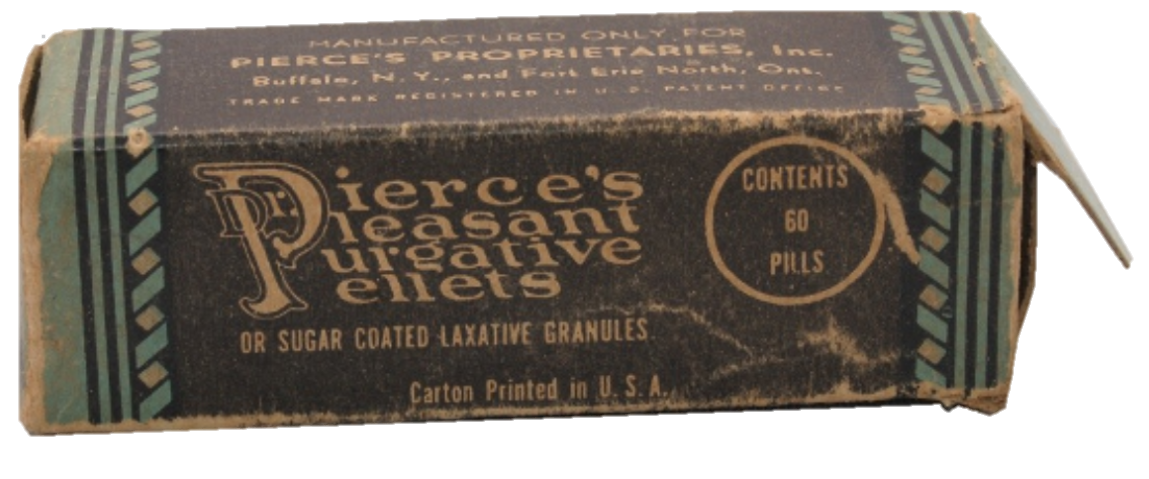
Dr. Ray Pierce was born in Stark New York on August 6, 1840. Graduating with a doctorate from the Eclectic Medical College in 1865, he moved to Buffalo New York in 1867 where he started The World’s Dispensary, a mail-order patent medicine business. To advertise his cures, Dr. Pierce made aggressive use of newspaper advertisements featuring patient testimonials, billboards, and postcards in addition to publishing The people’s Common Sense Medical Advisor (really just a collection of advertisement for his products). A savvy businessman, or possibly just taking a cue from other patent medicine manufacturers, Pierce attached his name on almost everything he sold, from “Dr. Pierce’s Pleasant Pellets” and “Dr. Pierce’s Extract of Smart-Weed” to “Dr. Pierce’s Golden Medical Discovery”, which for the most part were a mix of quinine, opium, and alcohol. Wildly successful, Dr. Pierce’s business was soon bringing in half-a-million a year, around $12,807,150 today. In 1878, Dr. Pierce opened the well-appointed Invalids’ Hotel and Surgical Institute and, turning his attention to politics, successfully campaigned to represent the 31st district of New York in the state Senate, where he served one term. Unfortunately, I haven’t been able to confirm that F.Z. Kimball & Co. or Lewis Litchfield’s General in neighboring Mundelein ever carried Dr. Pierce’s many cures. However, considering their wide availability and ads for them in local papers, it’s a safe bet that they probably carried at least one of his cures at some point.
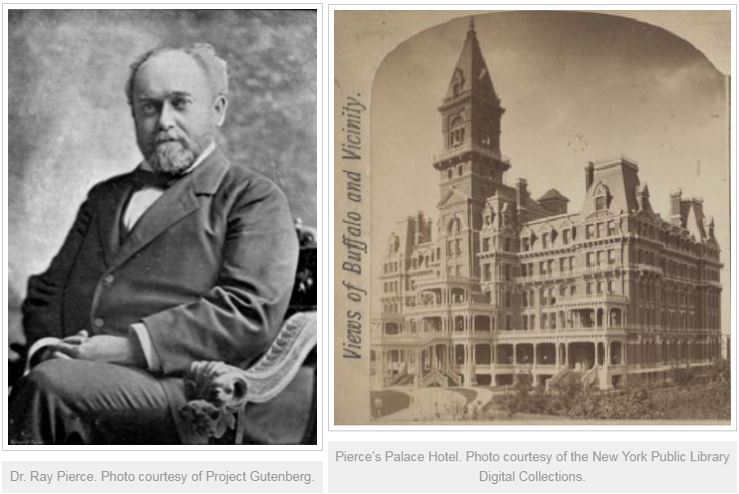
One product I can definitely say residents of both villages would have bought is Chamberlain’s Colic, Cholera, and Diarrhoea Remedy, thanks to a nice little ad by Lovell’s drug store I found in the Lake County Independent and Waukegan Weekly Sun.
Working his family’s farm after his father’s death in 1857, Lowell Chamberlain moved to New York City in 1865, working as a prescription clerk in Brooklyn while attending Cornell College of Pharmacy. Returning to Iowa in the summer 1872, whose residents at the time were suffering from “a great deal of…dysentery”. Sensing a business opportunity, Chamberlain entered into a partnership with Dr. Norman W. Owen, a graduate of Rush Medical College in Chicago, to start Owen & Chamberlain. Working out of a well-stocked storeroom located at No. S North Park Row, the business quickly became well known locally for its O & C’s Standard Remedies. Chamberlain’s brother Davis bought out Dr. Owen’s share of the business in 1892, with the brothers renaming the company Chamberlain Medical Co. In addition to the Colic, Cholera, and Diarrhoea Remedy advertised by Lovell’s drug store, Chamberlain also sold Chamberlain’s Liniment, Chamberlain’s Eye and Skin Ointment, and Chamberlain’s Pain Balm (are you seeing a naming theme here?).
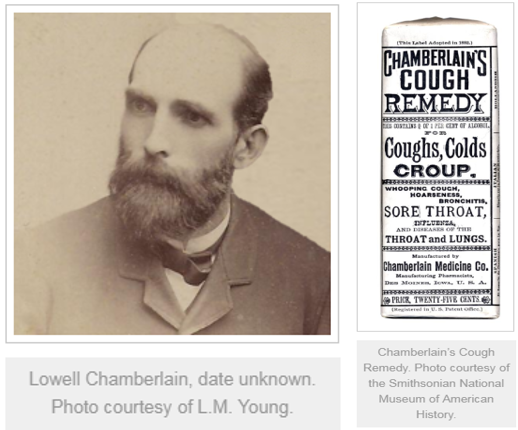
By 1900, the number of patents held by Chamberlain Medical Co. had grown substantially, it had just opened a new factory, and their products, along with copies of Chamberlain’s Almanac, were being shipped across the nation. Flush with cash, Davis Chamberlain decided to spend a bit, commissioning a Boston architect to build a Jacobethan Revival style mansion for him. Located at 3520 Grand Ave., the mansion became affectionately known as the “West Chester”, with the plans even appearing in the May 2, 1903 issue of The American Architect and Building News titled “A House in Iowa.”
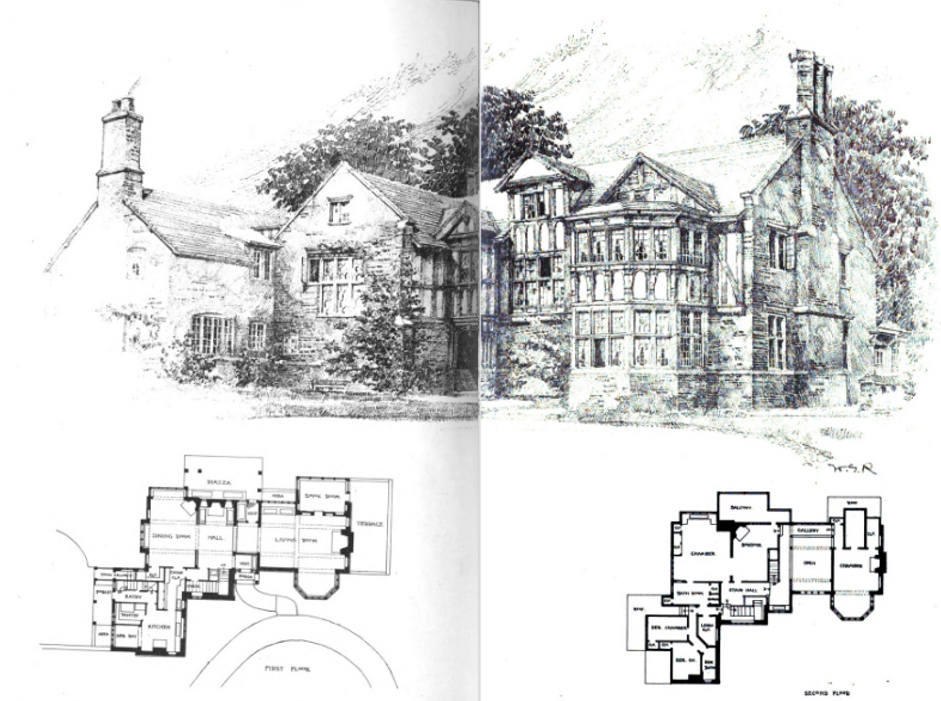
Another product that, was sold in neighboring Waukegan, and probably have be bought in Libertyville was D.D.D. Prescription. Named after its creator, Dr. Decatur Dilworth Dennis, the balm was marketed as a cure for eczema, rashes, and all manner of skin-related ailments. Born in Lamar County, Texas in December 1858, he had a difficult childhood, losing both his parents while he was still young and subsequently going to live with an uncle. While I was unable to find where he went to medical school, by 1897 he had moved to St. Louis, MO., and is listed in The Druggists’ circular and chemical gazette as president of the D.D.D. Co. Making use of the now-standard patient testimonials, free samples, along with graphic before-and-after illustrations to prove the efficacy of his cures, his ads proclaimed that his cures were “not merely a commercial matter [but] a matter of humanity”. Said cures, when later analyzed, turned out to be 65% alcohol, 22% water, as well as Chloral hydrate, which could cause various unpleasant side effects. In 1900, he moved again, this time to Chicago, where he collaborated with William E. Bristol and John W. Baker to raise $10,000 ($304,932.14 today) to incorporate D.D.D. Co., which by this time was operating out of a storefront at 70 Dearborn St. Chicago. By 1910, however, John Baker is listed as president of the company, with Dennis having moved back to Denison, TX.
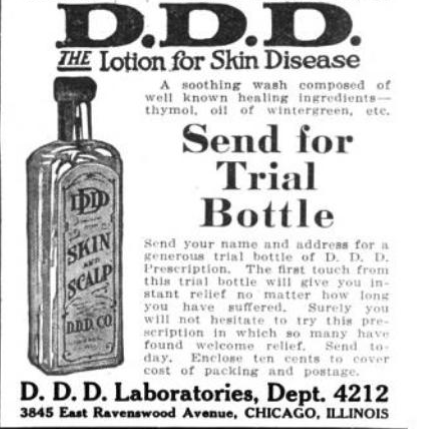
As the 19th century gave way to the 20th, the so-called golden age of patent medicine slowly came to a close. Muckraking journalists like E.W. Kemble and Samuel Adams published devastating exposés on the dangers of patent medicine, along with increasingly vocal criticism by doctors and professional medical societies. This eventually led to the signing of the Pure Food and Drug Act into law by President Theodore Roosevelt on June 30, 1906. Dr. Decatur Dennis continued to ply his trade in southern Texas until his death at age 72 in 1930. The company he’d started outlasted him, with ads for the D.D.D. Prescription appearing as late as the 1950’s. Dr. Ray Pierce eventually retired, passing away at his home on St. Vincent Island, Florida in 1914. Lowell and Davis Chamberlain, now millionaires, would go on to sell off the Chamberlain Medicine Co. in 1925 while the “West Chester” was eventually converted into a retirement home in 1949. Decades later in 1984, the estate was added to the National Register of Historic Places.
Anyway, I hope you enjoyed my post and that you’ll join me for my next dive into the (sometimes tangentially related) history of Mundelein and Libertyville! This post took a lot out of me though, so I’m off to put on my magnetic bracelets and use some homeopathic remedies. Stay healthy everyone!
A History of the City of Buffalo: Its Men and Institutions: Biographical Sketches of Leading Citizens. Buffalo, NY: Buffalo Evening News, 1908. Accessed July 22, 2019. https://archive.org/details/historyofcityofb00buff/page/194.
Arkansas, County Marriages Index, 1837-1957. Ancestry.com. Accessed July 26, 2019. https://search.ancestrylibrary.com/cgi-bin/sse.dll?dbid=2548&h=2105167&indiv=try&o_vc=Record:OtherRecord&rhSource=2272.
“Around the County.” Lake County Independent (Libertyville), March 13, 1896. Accessed July 18, 2019. http://vitacollections.ca/cmpldnewsindex/3169261/page/8?q=Litchfield&docid=OOI.3169261.
“Around the County.” Lake County Independent (Libertyville), July 10, 1896. Accessed July 18, 2019. http://vitacollections.ca/cmpldnewsindex/3169278/page/8?q=Litchfield&docid=OOI.3169278.
“Balm of America: Patent Medicine Collection — History.” National Museum of American History. Accessed July 23, 2019. https://americanhistory.si.edu/collections/object-groups/balm-of-america-patent-medicine-collection/history.
Cramp, Arthur. “D.D.D.” Nostrums and Quackery: Articles on the Nostrum Evil and Quackery 2 (1921): 498. Accessed July 25, 2019. https://books.google.com/books?id=Ngo2AQAAMAAJ&pg=PA498&lpg=PA498&dq=d.d.d. patent medicine&source=bl&ots=J9Cf5c3bmG&sig=ACfU3U0yClyh5llbS8K2C4vHwR3wcclJiA&hl=en&sa=X&ved=2ahUKEwiqhsP4-9DjAhUjB50JHQVpBwIQ6AEwD3oECAgQAQ#v=onepage&q=d.d.d. patent medicine&f=false.
D.D.D. Laboratories. “D.D.D. The Lotion for Skin Disease.” Advertisement. Railway Maintenance of Way Employes Journal, 1922, 129. Accessed July 30, 2019. https://books.google.com/books?id=lD5WAAAAYAAJ&pg=PT121&lpg=PT121&dq=D.D.D.+Laboratories,+Dept+4212&source=bl&ots=5tL-kO60jx&sig=ACfU3U2IfehDPP8PP5sZGLFIpBkYXUakCA&hl=en&sa=X&ved=2ahUKEwi44fWqseTjAhVQRqwKHaHRDjAQ6AEwAHoECAsQAQ#v=onepage&q=D.D.D.%20Laboratories%2C%20Dept%204212&f=false.
DOCTOR Decatur Dillworth “D D” Dennis II 1858–1930. Family Tree. Ancestry.com. Accessed July 26, 2019. https://www.ancestrylibrary.com/family-tree/person/tree/159912251/person/272094619668/story.
Dr. Pierce’s Pleasant Purgative Pellets. Photograph. The Herb Museum. The Herb Museum, n.d. The Herb Museum. http://www.herbmuseum.ca/content/dr-pierces-pleasant-purgative-pellets.
The Druggists’ Circular and Chemical Gazette 41 (1897): 206. Accessed July 25, 2019. https://babel.hathitrust.org/cgi/pt?id=mdp.39015084620486&view=1up&seq=206.
Eberle, Scott G., and Joseph A. Grande. Second Looks: A Pictorial History of Buffalo and Erie County. Norfolk, NY: Donning, 1987.
Felter, Harvey W. History of the Eclectic Medical Institute, Cincinnati, Ohio, 1845-1902 : Including the Worthington Medical College (1830-1842), the Reformed Medical School of Cincinnati (1842-1845), and the Eclectic College of Medicine (1956-1859), with Biographical Sketches of Members of the Various Faculties and Lists of Graduated Arranged Alphabetically and by Classes. 1902. Accessed July 22, 2019. https://digital.cincinnatilibrary.org/digital/collection/p16998coll15/id/215561/rec/3.
Griffin, Jessica. “Foley & Co., Chicago, IL.” Old Main Artifacts (blog), December 3, 2014. Accessed July 11, 19. https://oldmainartifacts.wordpress.com/2014/12/03/foley-co-chicago-il/.
Kang, Lydia, and Nate Pedersen. Quackery: A Brief History of the Worst Ways to Cure Everything. New York, NY: Workman Publishing, 2017.
L.H. Litchfield. “Kodol Dyspepsia Cure.” Advertisement. Lake County Independent (Libertyville), February 3, 1899. Accessed July 15, 2019. http://vitacollections.ca/cmpldnewsindex/3169480/page/5?n=.
Leonard, John W., and Albert N. Marquis. The Book of Chicagoans : A Biographical Dictionary of Leading Living Men and Women of the City of Chicago. Vol. 2. Chicago, IL: A.N. Marquis &, 1911. Accessed July 19, 2019. https://archive.org/details/bookofchicagoans1911leon/page/240.
Lovell’s Drug Store. “Go To Lovell’s Drug Store for Drugs, Medicines, Chemicals.” Advertisement. Lake County Independent (Libertyville), February 3, 1899. Accessed July 18, 2019. http://vitacollections.ca/cmpldnewsindex/3169480/page/5?n=.
Mingus, Nancy B. Buffalo: Good Neighbors, Great Architecture. Arcadia Publishing, 2003.
Miriam and Ira D. Wallach Division of Art, Prints and Photographs: Photography Collection, The New York Public Library. “Pierce’s Palace Hotel.” New York Public Library Digital Collections. Accessed August 2, 2019. http://digitalcollections.nypl.org/items/510d47e1-4dbc-a3d9-e040-e00a18064a99.
Morrison & Fourmy. Morrison & Fourmy’s General Directory of the City of Galveston: 1899-1900. University of North Texas Libraries. Accessed July 26, 2019. https://texashistory.unt.edu/ark:/67531/metapth894022/m1/95/?q=%22D.D.D%22.
Photographs courtesy of Project Gutenberg, the New York Public Library Digital Collections, Google Books, L.M. Young, the Smithsonian National Museum of American History, The Herb Museum, and the HathiTrust Digital Library .
Rantoul, William G. “A House in Iowa.” American Architect and Building News. (May 1903): 102-03. April 09, 2019. Accessed August 09, 2019. https://babel.hathitrust.org/cgi/pt?id=iau.31858033422589&view=2up&seq=102.
“R.V. Pierce, M.D.” Digital image. May 28, 2006. Accessed July 19, 2019. http://www.gutenberg.org/files/18467/18467-h/18467-h.htm.
United States of America. Reports to the General Assembly of Illinois. Vol. 1. Springfield, IL: H.W. Rokker, 1897. 66. June 18, 2007. Accessed July 18, 2019. https://books.google.com/books?id=uKE3AAAAMAAJ&pg=PA66&lpg=PA66&dq=L.H. Litchfield Rockefeller IL&source=bl&ots=zjiym42cSv&sig=ACfU3U2NtaPLftJrAVDV0-JkiQrwfQgZVw&hl=en&sa=X&ved=2ahUKEwjDnKPUpb_jAhUICM0KHcjQA14Q6AEwCnoECAkQAQ – v=onepage&q=L.H. Litchfield Rockefeller IL&f=false#v=snippet&q=L.H. Litchfield Rockefeller IL&f=false.
United States of America. United States Patent and Trademark Office. Annual Report of the Commissioner of Patents to Congress for the Year Ending December 31, 1880. Washington, DC: U.S. Government Printing Office, 1881. 245. Accessed July 23, 2019. https://books.google.com/books?id=ZYOa5DC7msEC&pg=PA245&lpg=PA245&dq=owen & chamberlain iowa patent medicine&source=bl&ots=M2ypSQwB0_&sig=ACfU3U0IyezjfEpkKHHkXsn-K3YAzQ5XTw&hl=en&sa=X&ved=2ahUKEwjY87en9cvjAhXWQs0KHRaFAEoQ6AEwCHoECAgQAQ#v=onepage&q=owen & chamberlain iowa patent medicine&f=false.
The Western Life-Boat and Journal of Biography: Containing Pen-sketches of Men of Our Times, Illustrated by the Laws of Psysiognomy, Psychometry and Phrenology, V.1, Volume 1. Vol. 1. Des Moines, IA: Western Life-boat Publishing Company, 1873. Accessed July 23, 2019. https://books.google.com/books?id=NoeMX7HLa1MC&pg=PA370&lpg=PA370&dq=Dr. N.W. Owen and Chamberlain&source=bl&ots=IfvaK3jmTC&sig=ACfU3U3y7BK-F-zOugIFtyW2uSyPWKJj4w&hl=en&sa=X&ved=2ahUKEwigmu-D68vjAhVFYs0KHRnPCXQQ6AEwDXoECAgQAQ#v=onepage&q=Dr. N.W. Owen and Chamberlain&f=false.
“World’s Dispensary Medical Association. Proprietors of Dr. Pierce’s Family Medicines. Buffalo, N.Y.” Ray Vaughan Pierce, Dr. to The Retail Drug Trade of America. 1890. In Library Company of Philadelphia. PA. Accessed July 23, 2019. https://digital.librarycompany.org/islandora/object/digitool:118263.
Discover more from Cook Memorial Public Library District
Subscribe to get the latest posts sent to your email.
Categories: Local History
Tags: Local History
